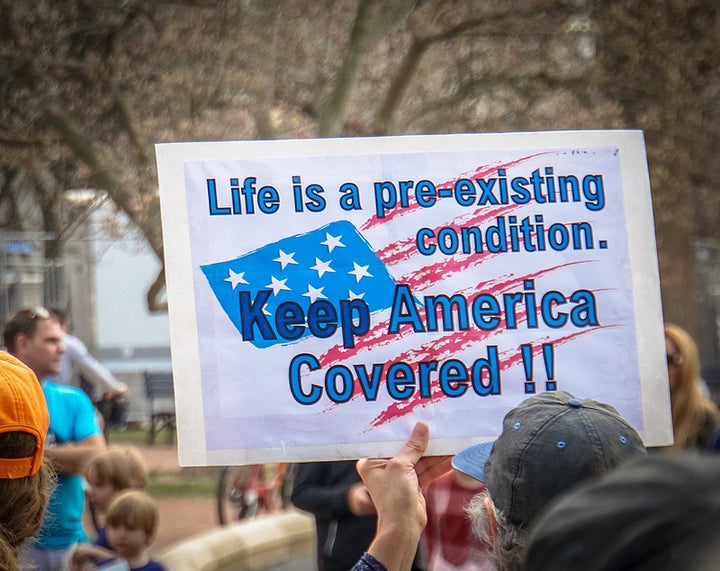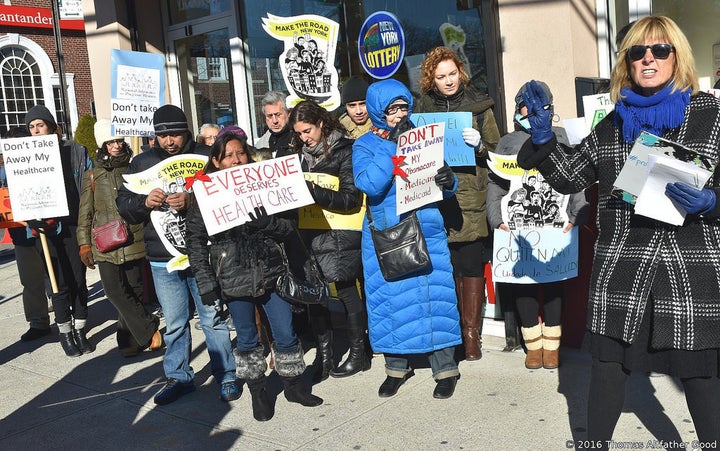
Rally in Support of the Affordable Care Act. Image licensed under Creative Commons.
There are not just two sides of the political aisle on the ACA, there is a diverse range of experiences. If you want to know more about individual commendations and condemnations, the New York Times did a great series of interviews in their January 29th issue.
What emerges from those interviews is the stuff we instinctively know—that someone’s life has been saved; others are strapped by the premiums. Why? As you read the stories it becomes clear that it’s because annual premiums are unregulated, and it’s left to insurance companies to decide what the market will bear. The majority of negative stories come from sparsely populated towns and counties with few insurance alternatives, where companies can charge whatever they see fit. Most commercial insurers are large profit-driven corporations with boards, stockholders, and expensive CEOs; nevertheless, their pool of insureds could be dealt with more fairly and affordably. Right now it’s capitalism at its most short-sighted, benefitting one company in the short term at the expense of both its customers and the economy as a whole.
Because that’s what the ACA is about—the economy.
To us, it’s our individual bodies and bank accounts that are affected, but the government looks beyond our personal situation to the aggregate of how citizens affect the economy. In Cuba, this relates to socialism but—surprise, surprise—in this country it relates to capitalism. It’s about keeping working people, or would-be workers who benefit least from the economy, healthy enough to drive it forward anyway.
Sick people are not productive and single mothers, or parents of sick children, tend to produce only as much as they have to in order to keep their families functional. People who can afford health insurance are generally in better-paid, white-collar jobs. People who cannot afford health insurance often work for the first group, and the reliability and quality of their labor are important. Their bosses want them to show up, perform to an agreed standard, and not spread disillusion and discontent within the workforce. It’s not Bhutan, where happiness is considered important to the nation, it’s the USA—just give us the basics and we’ll make our own happiness.
America has shored up capitalism before. In the Depression of the 1930s, the vast numbers of unemployed started to become hopeless and thus politically restless. Roosevelt’s New Deal was designed to steer them away from both Socialism and Fascism. FDR put people back to work, constructing much-needed infrastructure for the nation. It was a figuratively and often literally elegant solution, providing social control in the form of a sort of romantic Modernism—an America of muscular dams, soaring bridges, and ambitious highways. Practically, it offered industries greater access to markets scattered across the vast continent.
Further, Roosevelt and his cabinet knew that low-level employment was not going to be enough—some sort of guarantee was required to provide people with a feeling of stability: The Social Security Board was put in place in 1935, drastically reducing the poverty rate of older Americans, lessening the burden on working people and giving the middle classes a durable economic fix. Capitalism works! Medicare and Medicaid followed in 1965, but they were targeted programs never meant to serve the entire population.
In contrast, England embraced the National Health Service as part of rebuilding the country after the physical and financial devastation of World War II. While the wealthy did not see much change in their bank balances at the end of the war, the middle and lower classes had lost a vast number of people as well as places to live—plus they had gone without a lot of necessities, including adequate food. Britain, which had managed to stay Conservative during the war without veering into Fascism, was faced with the dissatisfaction of most of its population by the end of it.
In 1945, the British did not vote Winston Churchill back into office, no matter how well they thought of him as a wartime leader. A Labour government was elected and, by 1948, the National Health Service was in place. Britain needed every adult alive to be at work. Access to health care for those servicemen and women who returned from the war, as well as their families, was the most effective way to focus the nation on rebuilding its economy. Healthcare was not a stipend or a pension, rather it solved needs as they arose and thus served to bring some equality to all families. Everyone could see a doctor. From cancer to wound complications, from pregnancy to dentistry, the National Health Service pulled the poor and damaged out of a potential spiral of dwindling resources and hopelessness that could lead to strikes, political upheaval, and violence—or hardline Socialism. When the Conservatives were re-elected in the 1950s, they grumbled about the NHS, but they knew it had stabilized both the economy and the political environment to the point that they were in power once more.
In contrast, “Trump/Ryancare,” now having failed twice to come to a vote on the House floor, threatened to restrict or entirely withdraw health services from tens of millions of low- and middle-income Americans, eliminate eligibility and coverage regulations for everyone else, and further extend benefits to those who can well afford to pay for them. It supposedly came with a multi-billion dollar reduction in the deficit, but with massive tax cuts for the top five percent as part of the bargain this seemed an improbable outcome. It was not a good idea.
Bill Clinton’s campaign war-room slogan was “It’s the economy, stupid!” National healthcare, one form of which was pioneered by Hillary Clinton during her husband’s term, was seen as strategic. Yes, millions would benefit, but so would the other engines that drive our financial wellbeing as a nation. Cries of “Socialism!” from the right quashed the plan to our long-term detriment.
Universal healthcare is certainly a Progressive strategy but nevertheless, it reinforces the status quo. Obama became president when the economy was failing and the country was deeply divided. New political groups, most notably the Tea Party and the Occupy Movement, urged the country to split further during his term. Obama, always a centrist, held to his belief that he could unite the country and soothe its discontents. He and his advisors knew the beneficial effect that better access to health care would have on industry as well as the people whose health and financial conditions were troubled. Compromised, the Act missed some of its marks but it was and remains an economic stimulus, focused on the workforce rather than corporations and the rich.
Today, our economy is not struggling, but it is not as dominant as it was. China could and will outpace us unless we do something about it. Perhaps alt-righters would be just as happy with that. Perhaps, with their “pull out of NATO” philosophy, they really don’t want to bother with being a world power. But they won’t be bringing the 1950s back, a time when a series of strategies for American dominance, ranging from the Marshall Plan to domestic policy, lead to high employment and a relatively even distribution of wealth. Even the fifties didn’t all work out as planned and American influence wasn’t all beneficial, but it pulled a great many countries together that had been laid waste, and helped us evolve through all the internal changes of the latter half of the twentieth century as a visibly Liberal democracy that was admired by many.
Right-wing Capitalists, we’re not asking for your hearts, but please—use your brains!

Rally in support of the Affordable Care Act, Staten Island. Image licensed under Creative Commons
This blog was previously posted on the Sanity Papers, March 26, 2017. Follow Sanity Papers on Facebook for updates.
